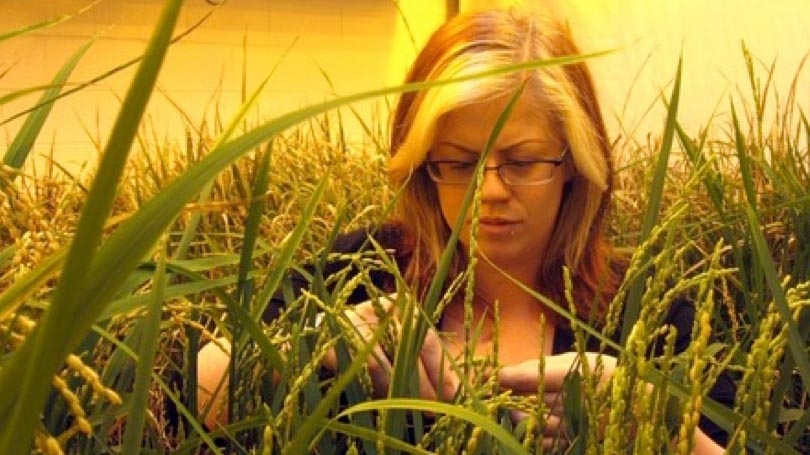
Jennifer Conrad is the recipient of a prestigious pre-doctoral fellowship from the USDA National Institute of Food and Agriculture for her work on the role of plant hormone cytokinin in the architecture of rice root systems.
With the human population exponentially increasing, there is a major concern regarding how to feed everyone. According to the United States Department of Agriculture (USDA), over half of the world’s population consumes rice as their primary staple. Regions such as Asia, South America, and Sub-Saharan Africa are the leading consumers. Although rice is popular, the production costs are extensive and the yields are not enough for growing populations. Jennifer Conrad, a 6th year Ph.D. candidate in the lab of Dr. Eric Schaller at Dartmouth College, hopes to solve some of these problems.
Conrad began thinking about plants and crop sustainability during her undergraduate career at Green Mountain College. At Dartmouth, she has continued that focus and was awarded a prestigious predoctoral fellowship from the USDA to complete her work. Conrad believes her research stood out to the USDA grant committee because it called attention to a health and climate crisis with an opportunity to create solutions. In August 2017, she will be presenting in Washington, D.C. at the USDA to discuss the newest findings in her research and future directions with top researchers in the field. Her work, titled "Cytokinin and its role in root system architecture," focuses on the plant hormone cytokinin, which is known for its role in cell division. Cytokinin supports elongation and branch formation of the roots and shoots of plants. Root structure is essential for rice growth because the crop is primarily grown in wet soils that require an extensive network of roots to ground the plant. The way in which cytokinin regulates the growth and branching actions is a mechanistic question that remains unanswered.
Conrad is using CRISPR-Cas9 technology to try to find out more about this process. CRISPR-Cas9 is a method by which a researcher can specifically and efficiently remove or mutate a gene. Doing this eliminates the expression of this gene into protein. As an analogy, consider making a peanut butter and jelly sandwich where the pantry represents the cell and the ingredients for the sandwich are the genes. Going into the pantry, getting the ingredients, and making a sandwich would be like the functioning of a “normal” cell that is unaffected by CRISPR-Cas9. However, if CRISPR-Cas9 is utilized, it would remove the peanut butter from the pantry, thereby eliminating the possibility to use it to make the sandwich. The rest of the sandwich can still be made because the other ingredients are still in the pantry; however, it would not contain peanut butter. Human cells have many more genes than the number of ingredients in a sandwich, but the concept is the same. A target gene (peanut butter) can be eliminated without disrupting the other genetic information (the jelly and bread) stored in the cell (the pantry).
Using CRISPR-Cas9, Conrad targets type B response regulators. Type B response regulators are a family of transcription factors (i.e., molecules that regulate the expression of a set group of other genes) that provide the plant’s response to cytokinin. This means that when plants are exposed to cytokinin, the hormone acts on these type B response regulators to create a response of increased root growth in the plants. Without these type B response regulators, plants do not respond to cytokinin. As the name suggests, there are a few different members of the type B response regulator family. Conrad’s goal is to selectively eliminate each one and determine the role each member plays in the growth and branching of rice roots and shoots. Preliminary data showed that the elimination of one of the members decreased root branching and decreased the plant’s response to cytokinin.
Conrad’s results are exciting and groundbreaking. However, many of the countries that rely primarily upon rice for food are culturally resistant to synthetically modified foods. However, using CRISPR-Cas9 technology provides a way to allow for selective breeding that already occurs in these cultures, such as farmers mating two rice plants that hold on to their rice tighter than the other rice plants—this trait is desirable so the farmer doesn’t lose crop in the water. Mating those two rice plants to make offspring that also have this trait may be useful. In a similar manner, the information discovered by Conrad and the Schaller lab has the potential to create naturally occurring breeding pairs that produce drought resistant and higher yielding rice crops. Additionally, these findings could also be applied to other monocots, including cereal grains and fruits and vegetables, such as yams, onions, bananas, and ginger.